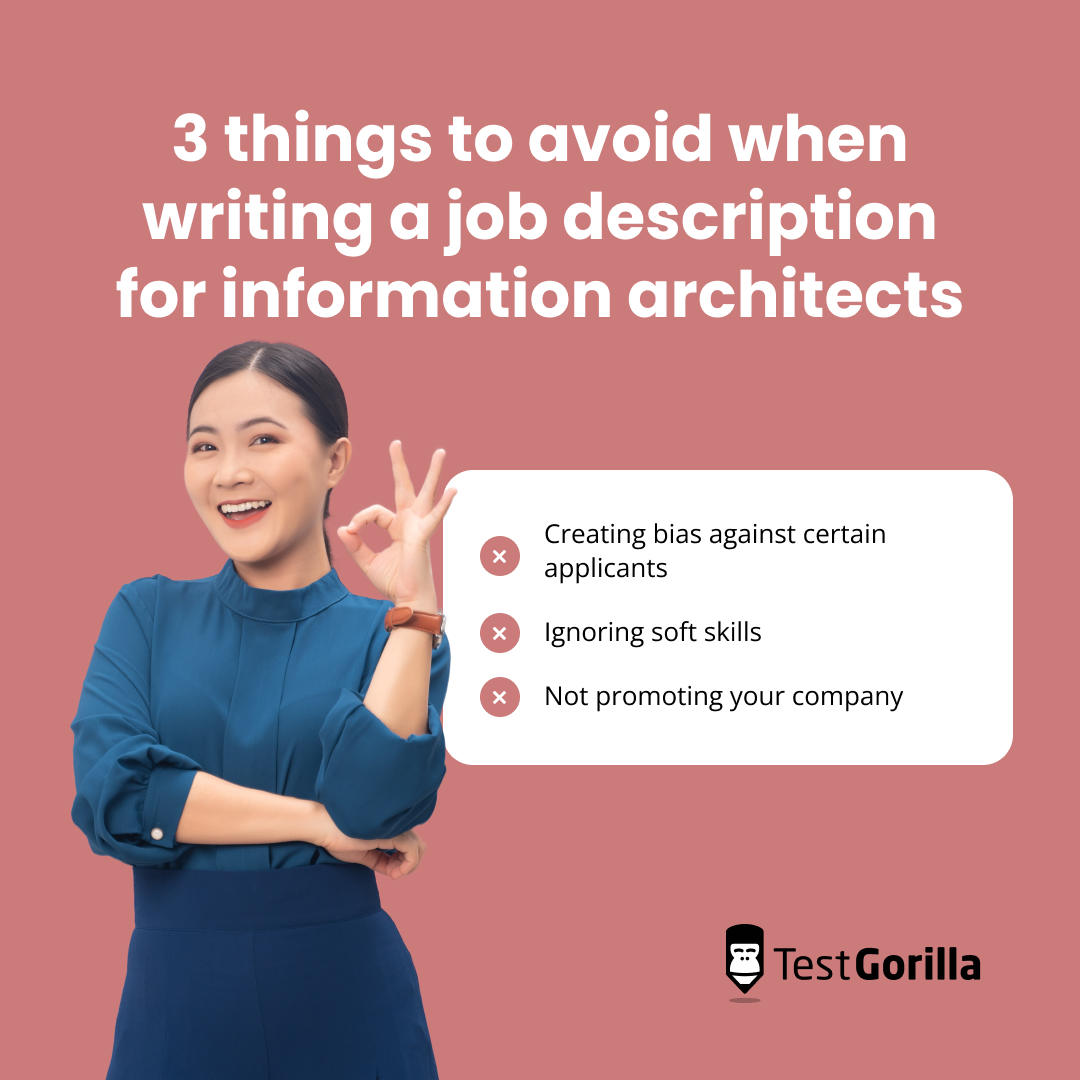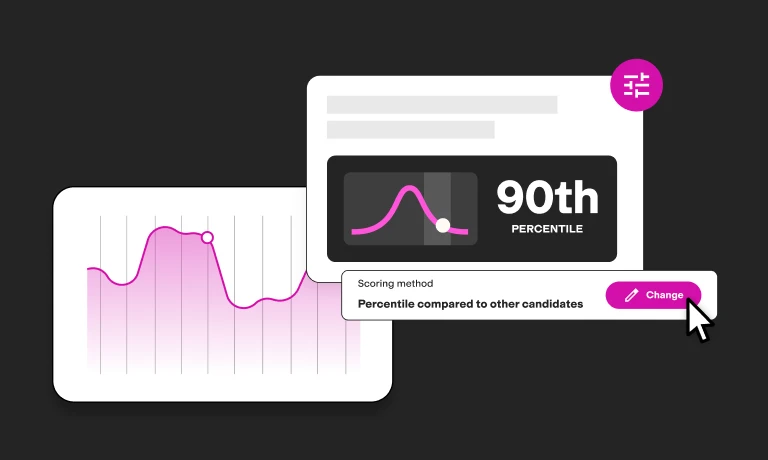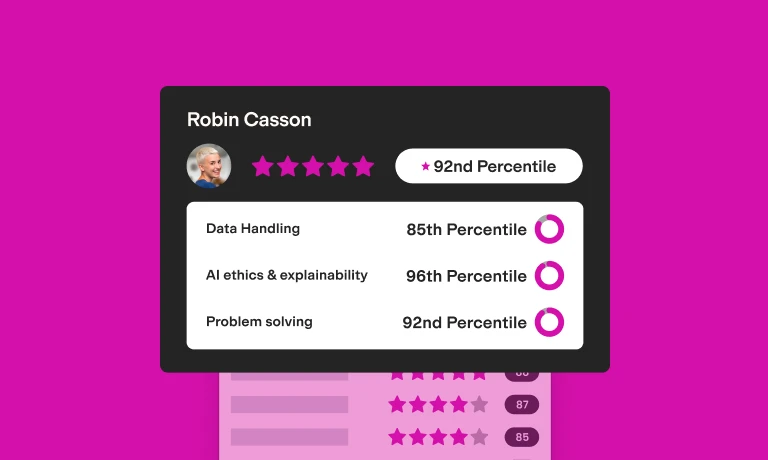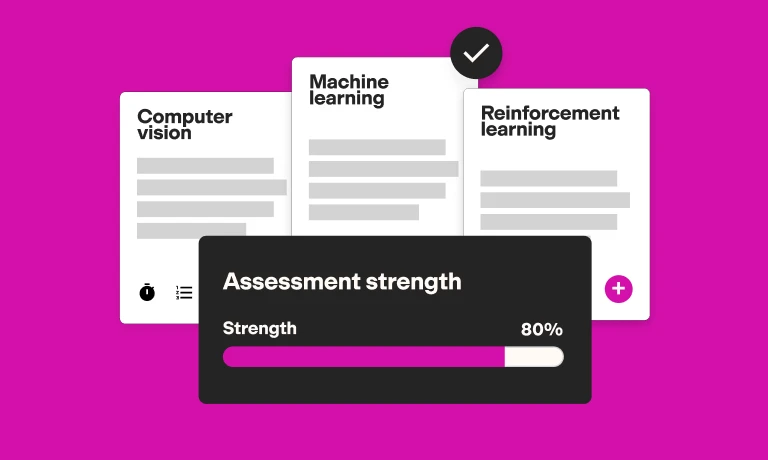A well-written information architect (IA) job description can help you hire the best candidate. Your job description outlines your vision for the IA you need, including what they’ll work on and how they’ll fit in with your company.
However, writing the perfect IA job description is challenging. Qualifications vary according to whether you need an entry-level or experienced IA. Additionally, talent assessment software tools and best practices change frequently. A job description that doesn’t stand out can leave you with a candidate pool of less-than-stellar IA applicants.
This guide explains how to write an IA job description that attracts top candidates and outlines essential qualifications.
Table of contents
- What is an information architect?
- Key skills to look for in an information architect
- How to write an effective information architect job description
- Information architect job description template
- 3 things to avoid when writing a job description for information architects
- Next steps: Attracting and assessing information architecture candidates
- FAQs
- Hire top information architects with TestGorilla
What is an information architect?
An IA is responsible for organizing information on a website or piece of software. Their role relates to user interface (UI) design but focuses more on the behind-the-scenes structure of a digital experience.
Information architects are typically responsible for creating sitemaps and menu hierarchies. With good information architecture, users will always know where they are within a website or digital experience.
Key skills to look for in an information architect
IA candidates should bring these skills to your business:
Programming: Proficient in programming languages commonly used to build websites, including Java, HTML, and CSS
Wireframing: Comfortable building product wireframes in Adobe Illustrator, Photoshop, or similar programs
Site mapping: Can build sitemaps and hierarchical navigation menus for new or existing websites.
Critical thinking: Possess strong problem-solving skills for helping users navigate complex products
Communication: Can clearly communicate about their sitemaps and design choices with other team members, including UX, UI, and interaction designers
The best insights on HR and recruitment, delivered to your inbox.
Biweekly updates. No spam. Unsubscribe any time.
How to write an effective information architect job description
A strong IA job description must outline your vision for the ideal candidate, tell candidates about your company, and persuade them to work with you.
Here are four tips for writing an IA job description that stands out:
Be specific about the candidate you want
The more specific your job description is about the IA candidate you need, the more likely you are to receive high-quality applications.
Go beyond listing basic qualifications to describe in detail what your hire will do at your company. This could include outlining the first project they’ll work on and the IA aspects the project will emphasize.
Explain your company’s values
Top IA candidates want to work at businesses that match their values. So, it’s important to share what your company cares about. Include your company mission in your job description if you have one.
Highlight the perks of working for your business
Include a competitive salary range for your open IA role. Also, detail the non-monetary benefits your company offers candidates. These include paid time off, parental leave, and remote work.
These non-monetary benefits can make your company’s overall compensation more competitive and help you attract top IA candidates.
Ensure your job description is up to date
Software tools for information architecture and best practices for organizing websites change over time. Ensure that if you require candidates to have experience with specific software, that software is modern and widely used.
Information architect job description template
Here’s a template to follow for writing your IA job description:
Company introduction
Here, provide a brief overview of your company. Cover your company’s mission and products, and highlight important details – like when it was founded and its standing in your industry.
This section should also discuss the importance of IA to your company. You might describe how IA has contributed to specific products or enabled achievements, like reaching a milestone number of website visitors.
Benefits of working with [your company]
This section should provide a bulleted list of your company's non-monetary benefits, from sick leave to pet-friendly office policies.
You can also discuss your company’s culture and how it fosters a positive work environment.
Information architect job brief
[Company name]
Job Title: [For example, Information Architect or Senior Information Architect]
Reports to: [For example, Senior Information Architect, Chief Design Officer, or UX/UI Lead]
Position type: [Full-time, part-time, on-site, remote, or hybrid]
[Compensation details]
Information architect responsibilities
Build user-friendly sitemaps for our websites that promote engagement and conversion.
Create navigation hierarchies for our website, mobile apps, and digital products using modern design principles.
Run A/B and additional user tests to optimize website, app, and product navigation.
Produce wireframes using software like Adobe Illustrator and Photoshop to visualize users’ digital journeys.
Apply user feedback and emerging best practices to update existing product designs.
Collaborate with UX/UI team members and product managers to achieve design goals.
Report product sitemaps and design outcomes to product managers and executives.
Requirements/qualifications and training required
A [bachelor’s or master’s degree] in information architecture, computer science, information systems, or a similar field OR equivalent experience
[2+] years’ professional experience as an information architect
3 things to avoid when writing a job description for information architects
Watch out for these three things when writing your IA job description:
1. Creating bias against certain applicants
Your IA position should be open to all qualified candidates, regardless of race, gender, or age. Avoid gendered phrases like “dominate” or “fearless” since these can feel exclusive to female candidates. Removing biased language from your job description can also help you comply with employment laws to engage in fair hiring practices.
You can also encourage applicants from non-traditional backgrounds to apply by including phrases like “or equivalent experience” in your education requirements.
2. Ignoring soft skills
Soft skills like communication and collaboration are essential in a successful IA applicant. Ignoring these skills in your job description can turn away qualified candidates because they may assume that you’re only interested in applicants’ technical skills.
Specifically mention soft skills in your list of IA responsibilities. For example, you can include “collaborate with team members” as a responsibility.
3. Not promoting your company
Top IA candidates are likely applying to jobs from multiple companies. So, explaining why they should choose to work for your company is important.
Go beyond just providing a salary range. Discuss what makes your company’s culture great and what candidates can look forward to by joining your company.
Next steps: Attracting and assessing information architecture candidates
Once you have the perfect job description, you can post it on job sites and your company’s social media channels to attract a pool of qualified IA candidates.
After that, the next step is to quickly narrow down your applicants to a few finalists.
The best way to assess IA candidates is to use a combination of expert-designed tests and behavioral interview questions. Tests and interview questions can help you fully understand the value a candidate will bring to your company and reduce the chance of hiring an IA applicant who isn’t the right fit.
TestGorilla offers more than 350 tests you can use to evaluate candidates. Our library includes role-specific tests for programming skills, UX/UI design skills, Adobe Illustrator skills, and more.
You can combine these role-specific tests with soft skills tests to assess applicants’ collaboration and communication skills. TestGorilla also offers personality tests that help you better understand how candidates will fit in with your existing team.
FAQs
How much experience should an information architect have?
For a junior or entry-level IA role, two years’ work experience or a master’s degree may be sufficient. For a senior IA role, you should require candidates to have at least five years of work experience.
Should my information architect job description include a salary range?
Laws require employers in some states, including California and Colorado, to provide salary ranges in every job description. For employers in other states, providing a salary range helps attract top candidates by showing that your company plans to offer competitive compensation.
Hire top information architects with TestGorilla
Hiring the best IA candidate can help your company build engaging digital experiences. Begin by creating a compelling job description that clearly explains what you’re looking for in an IA applicant.
Attracting applicants with your job description is just the first stage of your hiring process. Once you have IA candidates, you can use TestGorilla to evaluate them using role-specific skills tests, soft skills tests, and personality tests.
Sign up for a free TestGorilla account to build your first assessment, or sign up for a product demo to see how TestGorilla can help you hire the best IA candidate.
You've scrolled this far
Why not try TestGorilla for free, and see what happens when you put skills first.















